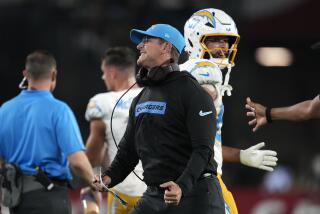Tommy Herr Escapes ‘Bad Actor’ Image : He Becomes an All-Star Hit With Consistency at Second and the Plate
MINNEAPOLIS — He grew up in Lancaster, Pa., light years away from Sunset Boulevard, but they called Tommy Herr “Hollywood” when he first arrived in St. Louis five years ago as a 24-year-old rookie infielder for the Cardinals.
“I think it was because I was blond and looked like a California boy,” Herr says now, with deep-set eyes and a loose perm that make him indistinguishable from the surf set.
But Herr had more than that certain look. To Ken Boyer, there was something about Herr’s attitude that struck him as Hollywood--as in, bad actor. One day during batting practice, while Herr was standing in the outfield, Boyer marched out to him for what Herr described as a verbal exchange.
“Actually, it was pretty one-sided,” Herr said. “He chewed my butt out. I was a rookie, so I didn’t have much of a rebuttal.
“And I was scared. I was overwhelmed that he chose to do that in the outfield, during batting practice, in front of everybody.
“Boyer felt I had an attitude problem, which I felt was way off-base. The mood of that team was real laid-back, and I was just trying to blend in. As I rookie, I didn’t want to make any waves.
“I’ve always played hard, and I’ve never been flashy or showy. I play the way I do now.”
These days, they have another name for the way Herr plays. They call him All-Star, befitting a man who beat out last season’s MVP, Ryne Sandberg, in the fans’ balloting for the National League’s starting second baseman.
Herr goes into tonight’s game in the Metrodome as the league’s second-leading hitter with a .334 average and is second in RBIs to Atlanta’s Dale Murphy with 68, even though he has only three home runs and never had driven in more than 49 runs in a full season.
Vince Coleman and Willie McGee, the conejos who bat in front of Herr, and Jack Clark, the slugger who hits behind him, have received most of the credit for the Cardinals’ first-place standing in the National League East. But Herr, who nearly went to Duke on a basketball scholarship, has been the Cardinals’ most consistent hitter. No flash, no glitter, no Hollywood. More Main Street than Melrose Avenue.
“He’s underrated, anyway,” said Whitey Herzog, the Cardinal manager who resurrected Herr’s career after Boyer nearly buried him.
“He’s got a .276 average lifetime, and in 1983, when he had bad knees, he still was hitting .323 until he couldn’t play.
“He’s not that big a surprise. He’s very intelligent, and he’s in a good spot (No. 3) in the order. Even though he’s got the two jackrabbits (Coleman and McGee) in front of him, and Jack (Clark) behind him, he still has to do it.”
Herzog didn’t plan to bat Herr in the No. 3 spot. But Terry Pendleton faltered in the spring, Lonnie Smith was traded to Kansas City, and McGee, with his speed, was better suited to hit second. That left Herr, which has hardly hurt the Cardinals.
Herr got his chance when Herzog replaced Boyer in June 1980, with the Cardinals in last place. Only two players remain from that team: Herr and pitcher Bob Forsch.
“That’s pretty amazing,” Herr said. “Obviously, when Whitey took over, my position in the organization was tenuous at best.”
At first, it only got worse, when Herzog called Herr in and told him he was sending him back to the minors. But Herzog promised him that when a spot opened, he would bring him back, and when shortstop Garry Templeton went out with a knee injury in August, Herr returned and hit .337 in September.
That winter, Herzog traded third baseman Ken Reitz to the Cubs, shifted Ken Oberkfell from second to third, and told Herr he was his second baseman.
“I’d gone four or five months being a vagabond, getting sent up and down, and all of a sudden I had a regular job that was mine to lose,” Herr said.
In his first two seasons at second, Herr committed only 14 errors, the lowest total for any second baseman in the league. He also hit .268 in ‘81, .266 in ‘82, and except for one three-game period at the start of the ’82 season, did not go more than two games without getting a hit. The Cardinals won the World Series in ‘82, but just when Herr was ready to qualify for tenure in the infield, his knees blew out on him.
In 10 months, Herr had three operations on his knees. First the right one, then the left one while he was rehabilitating the right, then the right one again. The first surgery came in November, the last in August, which is when Herr’s season ended in 1983. There were those who wondered if his career might be next to go.
“As far as the amount of damage on my knees, it wasn’t significant enough for me to fear whether I’d ever play again,” Herr said. “My ligaments were structurally sound, I just had some deteriorated cartilage, and luckily, they had the arthroscope, which is a quick way to alleviate it.
“And I was encouraged even when I was injured, from the standpoint that I felt myself becoming a better hitter.”
Herr is a switch-hitter, although he started hitting from both sides much later than his 4-year-old son, Aaron.
“He’s got to be told to hit left-handed,” Herr said with a smile after his son took his cuts during the recent father-child game that preceded the Cardinals’ game with the Dodgers.
“If I just let him, he’d hit right-handed.”
Just like his father, who batted exclusively from the right side until Bob Kennedy persuaded him to switch in his first year of professional ball, in Johnson City, Tenn., in 1975. Herr said it took him five years to make the change.
“The ratio of batting left-handed to right-handed is about 3 to 1,” Herr said. “When you go four or five days without hitting right-handed, it’s tough to feel sharp. And it seems the left-handers you face, like Carlton, Valenzuela, Candelaria, there are a lot tougher. There aren’t as many left-handers, but there’s more quality.”
One thing Herr does not do is hit home runs. He went 1,161 big-league at-bats before hitting his first home run on May 10, 1983. Six games later, he hit another, but has only seven more since.
Normally, a No. 3 batter in the lineup hits for more power, but Herzog demurred. “When you’re hitting .360, you’re a normal third-place hitter,” Herzog said.
The challenge of driving in more than 100 runs without being a long-ball hitter appeals to Herr. “That would be a real compliment to a hitter like me,” he said. “It shows a certain amount of consistency to be able to do that without the home run.
“I’ve always thought of myself as a good hitter in the clutch. I think it was an astute move by Whitey to put me in the third spot.”
When the Cardinals faltered early last season, Herr, the one-time supposed problem child, criticized a few of his teammates for their lax attitude.
“I thought we were taking losing too lightly last year,” Herr said. “We got used to losing. ‘Hey, we lost another one, but so what, we’ll get ‘em tomorrow.’ I know it’s a long season, but you can only have that attitude so much. There’s a fine line between accepting defeat and just going out to avoid losing.”
More to Read
Go beyond the scoreboard
Get the latest on L.A.'s teams in the daily Sports Report newsletter.
You may occasionally receive promotional content from the Los Angeles Times.










